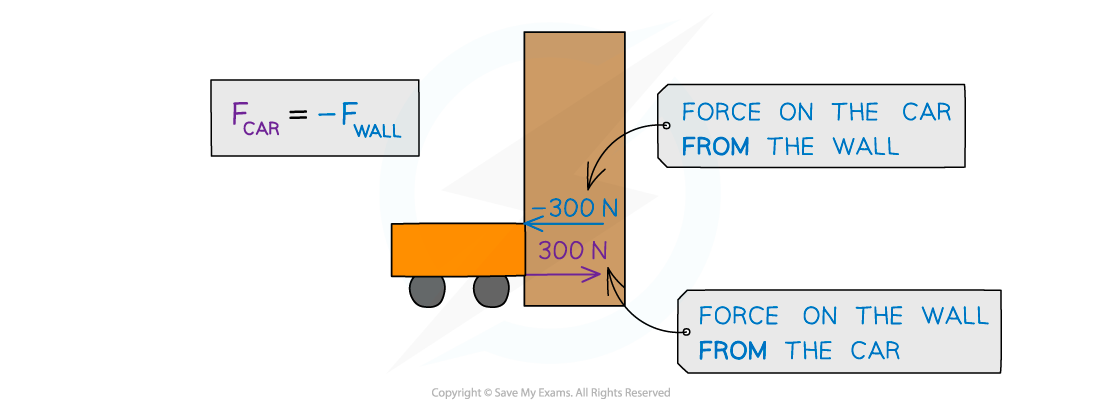Force & Momentum (Cambridge (CIE) AS Physics) : Revision Note
Force & momentum
Force is defined as the rate of change of momentum
Where:
F = force in newtons (N)
p = momentum in kilogram metres per second (kg m s-1)
t = time in seconds (s)
Δ (the Greek letter delta) = change in
Change in momentum, Δp, can also be expressed as:
change in momentum = final momentum − initial momentum
Force and momentum are vector quantities
They can have a positive or negative direction
Worked Example
A car of mass 1500 kg hits a wall at an initial velocity of 15 m s-1.
It then rebounds off the wall at 5 m s-1 and comes to rest after 3.0 s.
Calculate the average force experienced by the car.
Answer:
Step 1: List the known quantities and assign direction:
Mass, m = 1500 kg
Inital velocity, vi = 15 m s-1
Final velocity, vf = −5 m s-1
Time taken, t = 3.0 s
Step 2: State the equation for force and momentum
Step 3: State the equation for change in momentum
Step 4: Calculate the initial momentum
Step 5: Calculate the final momentum
Step 6: Calculate the change in momentum
Step 7: Calculate the force
Examiner Tips and Tricks
It is easy to forget to convert values to SI units and to assign directions to values during the calculation because your brain is focused on so many other things. Unfortunately, students often lose marks for this in exams. Therefore, it is good practice to get into the habit of performing these steps before you begin the calculation.
Direction of forces
The force that is equal to the rate of change of momentum is still the resultant force
The force on an object will be negative if the direction of the force opposes the direction of its initial velocity
This means that a force is exerted by the object it has collided with
Forces acting between a car and a wall upon impact

The force exerted by the wall on car will be equal in magnitude and opposite in direction to the force exerted by the car on the wall: Fcar = –Fwall
A car collides with a wall, and the car exerts a force of 300 N on the wall
The wall also exerts a force of −300 N on the car
The force exerted by the wall on the car is equal in magnitude and opposite in direction to the force exerted by the car on the wall
This is Newton’s third law of motion (see Newton’s laws of motion)
Time of impact
The force exerted is also determined by the time taken for the impact to occur
The same change in momentum, over a longer period of time will exert less force, and vice versa
As Δt increases, F decreases, when Δp remains the same
As Δt decreases, F increases, when Δp remains the same
Worked Example
A tennis ball hits a racket with a change in momentum of 0.5 kg m s-1.
The first ball has a contact time of 2.0 s. The second ball has a contact time of 0.1 s.
Determine which ball exerts the greatest force on the racket.
Answer:
Step 1: List the known quantities
Change in momentum, Δp = 0.5 kg m s-1
Change in time for the first ball, Δt1 = 2.0 s
Change in time for the second ball, Δt2 = 0.1 s
Step 2: Determine the force exerted by the first ball on the racket
Step 3: Determine the force exerted by the second ball on the racket
Step 4: State which ball exerted the greatest force on the racket
The second tennis ball exerted the greatest force on the racket
Examiner Tips and Tricks
In exam questions, look carefully at the cause and effect - which object is exerting a force on the other. Look out for key terms such as 'acts upon' and 'exerts'. It can be helpful to sketch a quick diagram to help you visualise the situation. This is particularly important when multiple values are given in the question, because not all of them may be relevant to the calculation.

You've read 0 of your 5 free revision notes this week
Unlock more, it's free!
Did this page help you?

